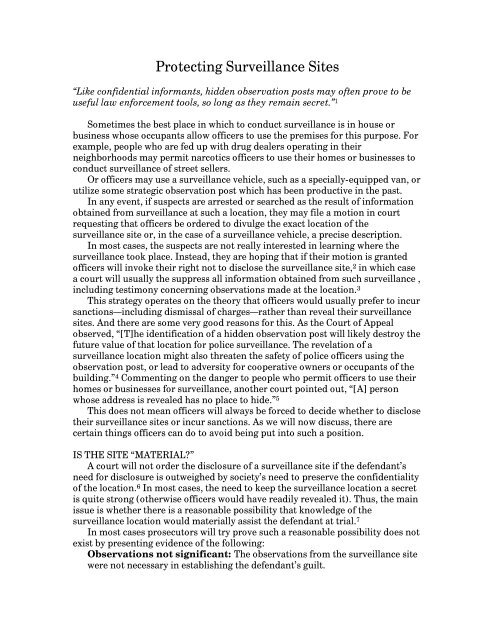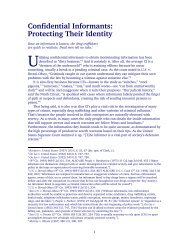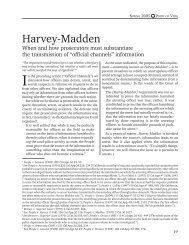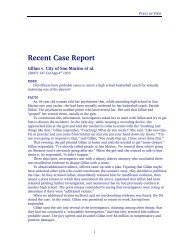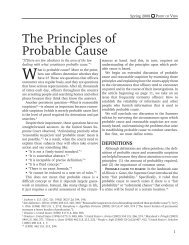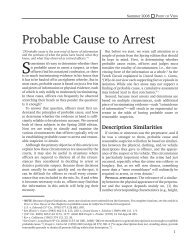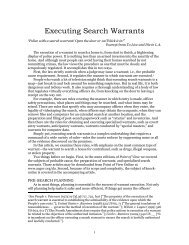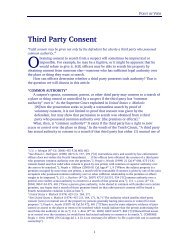Protecting Surveillance Sites - Alameda County District Attorney's ...
Protecting Surveillance Sites - Alameda County District Attorney's ...
Protecting Surveillance Sites - Alameda County District Attorney's ...
Create successful ePaper yourself
Turn your PDF publications into a flip-book with our unique Google optimized e-Paper software.
<strong>Protecting</strong> <strong>Surveillance</strong> <strong>Sites</strong><br />
“Like confidential informants, hidden observation posts may often prove to be<br />
useful law enforcement tools, so long as they remain secret.” 1<br />
Sometimes the best place in which to conduct surveillance is in house or<br />
business whose occupants allow officers to use the premises for this purpose. For<br />
example, people who are fed up with drug dealers operating in their<br />
neighborhoods may permit narcotics officers to use their homes or businesses to<br />
conduct surveillance of street sellers.<br />
Or officers may use a surveillance vehicle, such as a specially-equipped van, or<br />
utilize some strategic observation post which has been productive in the past.<br />
In any event, if suspects are arrested or searched as the result of information<br />
obtained from surveillance at such a location, they may file a motion in court<br />
requesting that officers be ordered to divulge the exact location of the<br />
surveillance site or, in the case of a surveillance vehicle, a precise description.<br />
In most cases, the suspects are not really interested in learning where the<br />
surveillance took place. Instead, they are hoping that if their motion is granted<br />
officers will invoke their right not to disclose the surveillance site, 2 in which case<br />
a court will usually the suppress all information obtained from such surveillance ,<br />
including testimony concerning observations made at the location. 3<br />
This strategy operates on the theory that officers would usually prefer to incur<br />
sanctions—including dismissal of charges—rather than reveal their surveillance<br />
sites. And there are some very good reasons for this. As the Court of Appeal<br />
observed, “[T]he identification of a hidden observation post will likely destroy the<br />
future value of that location for police surveillance. The revelation of a<br />
surveillance location might also threaten the safety of police officers using the<br />
observation post, or lead to adversity for cooperative owners or occupants of the<br />
building.” 4 Commenting on the danger to people who permit officers to use their<br />
homes or businesses for surveillance, another court pointed out, “[A] person<br />
whose address is revealed has no place to hide.” 5<br />
This does not mean officers will always be forced to decide whether to disclose<br />
their surveillance sites or incur sanctions. As we will now discuss, there are<br />
certain things officers can do to avoid being put into such a position.<br />
IS THE SITE “MATERIAL?”<br />
A court will not order the disclosure of a surveillance site if the defendant’s<br />
need for disclosure is outweighed by society’s need to preserve the confidentiality<br />
of the location. 6 In most cases, the need to keep the surveillance location a secret<br />
is quite strong (otherwise officers would have readily revealed it). Thus, the main<br />
issue is whether there is a reasonable possibility that knowledge of the<br />
surveillance location would materially assist the defendant at trial. 7<br />
In most cases prosecutors will try prove such a reasonable possibility does not<br />
exist by presenting evidence of the following:<br />
Observations not significant: The observations from the surveillance site<br />
were not necessary in establishing the defendant’s guilt.
Clear view: Even if the observations were somewhat material, the view from<br />
the surveillance site was so clear and unobstructed that there is no reasonable<br />
possibility the defense would be able to effectively challenge the accuracy of<br />
the officer’s observations.<br />
Observations not significant<br />
A surveillance location is less apt to be deemed material if the prosecution can<br />
prove the officers’ observations from the location were not necessary to establish<br />
the defendant’s guilt. There are essentially two ways of doing this: (1)<br />
Demonstrating that the evidence of defendant’s guilt—independent of<br />
surveillance—is so strong that the location of the surveillance site is irrelevant.<br />
(2) Demonstrating that because of the specific charges filed against the<br />
defendant, knowledge of the surveillance location is irrelevant.<br />
STRENGTH OF EVIDENCE: The greater the quantity and quality of the evidence<br />
of the defendant’s guilt, apart from surveillance, the less disclosure of the location<br />
is needed to assure the defendant of a fair trial. Thus, the prosecution may<br />
attempt to prove the evidence obtained as the result of surveillance is relatively<br />
insignificant in light of the other evidence.<br />
For example, if the defendant was charged with possession of drugs for sale,<br />
the materiality of the surveillance observations would be reduced to the extent<br />
the defendant’s intent to sell drugs could be established by other means; e.g., the<br />
drugs were packaged for sale, or the quantity of drugs in his possession was so<br />
great that it would have been beyond belief that they were intended for personal<br />
use.<br />
Thus, in People v. Garza, 8 the court in refusing to order disclosure noted,<br />
among other things, “[A]t the time of his arrest defendant had on his person four<br />
bindles of cocaine. [Narcotics officers] testified that four bindles of cocaine in<br />
defendant’s possession were sufficient to show that the possession was for sale. . .<br />
. [The officer] further testified that even removing from the evidence his<br />
observations from the surveillance location, he would still consider the four<br />
bindles in defendant’s possession as being possessed for sale.”<br />
Similarly, the significance of the surveillance observations would be reduced if<br />
the defendant admitted selling drugs or admitted engaging in the conduct which<br />
was observed by officers, or if person who purchased drugs was detained and<br />
found to be in possession of drugs. 9<br />
NATURE OF CHARGES: The importance of the surveillance observations may<br />
also be reduced or eliminated by the nature of the charges that were eventually<br />
filed against the defendant. 10 For example, if the defendant is charged only with<br />
straight possession of drugs or other contraband that was found in his<br />
possession, his actions observed during surveillance before the contraband was<br />
found would be much less material than if he was charged with possession with<br />
intent to sell.<br />
Clear view<br />
In many cases, the defense contends it needs to know the exact location where<br />
surveillance occurred in order to attack the accuracy of the officers’ observations
from the site; i.e., to prove there is a reasonable doubt as to what the officers’<br />
saw.<br />
This is commonly refuted by presenting evidence proving the officers’ view was<br />
unobstructed and there were no distractions or other reasons to doubt the<br />
accuracy of the officers’ observations. 11 Circumstances that should be brought to<br />
the court’s attention include the following:<br />
Distance: The distance between the surveillance location and activities that<br />
were observed from the location. 12<br />
Obstructions: Whether there were any obstructions that would impair the<br />
officers’ ability to see the activities that were observed from the location. 13<br />
Lighting and weather: Whether lighting and weather conditions would have<br />
impaired observations made from the surveillance site. 14<br />
Visual aids: Whether the officers’ observations were made through binoculars<br />
and, if so, their strength. 15<br />
Detailed observations: The extent to which the officers could provide details<br />
concerning their observations so as to demonstrate they had a good view of the<br />
location. 16<br />
Other people in area: Whether there were other people nearby and in such a<br />
position that officers may inadvertently attributed their actions to the<br />
defendant.. 17<br />
For example, in a case in which an officer was watching drug sales on a street,<br />
the court ruled the surveillance location was material because the officer<br />
testified he was watching appellant and three other men on the corner. “It is<br />
possible ,” said the court, “that discovery of the surveillance location would have<br />
shown that because of distance or partial obstruction, the officer could not have<br />
distinguished the activities of one suspect from those of another.” 18<br />
In another case, a surveillance location was ruled material when the drug<br />
transaction took place about 50 yards away, the officer watched the transaction<br />
through binoculars, and the weather was overcast. 19<br />
On the other hand, in People v. Walker 20 the court ruled the surveillance<br />
location in a drug sale case was not material because, among other things, the<br />
officer was standing 15 feet away from the drug transaction, it occurred in early<br />
October at about 5: 45 P.M. under good lighting conditions, the officer did not<br />
use binoculars, and he had an unobstructed view. As the court noted,<br />
“Defendant did not prove or even offer evidence to indicate that there was some<br />
point within the 15 feet to the rear of the building that the officer could not have<br />
observed him due to an obstruction.”<br />
Similarly, in In re Sergio M., 21 the court ruled that disclosure was not required<br />
based on testimony that the officer “was within 100 yards of the [suspect], and<br />
was using 35-power binoculars. He had an unobstructed view of the [suspect at<br />
all times]. It was clear and sunny that afternoon. Nobody else in the vicinity was<br />
dressed like the [suspect].” The officer also witnessed the transaction in which<br />
the suspect received money in return for a small object which, following the<br />
arrest of the buyer, was determined to be marijuana.<br />
HEARING PROCEDURE
If a defendant seeks the disclosure of a surveillance location which officers<br />
want to remain secret, prosecutors must respond by explaining, (1) why<br />
disclosure of the surveillance location falls within the “official information”<br />
privilege, or (2) declare they cannot provide such an explanation in open court<br />
without betraying the privilege.” 22<br />
The defendant then has the burden of demonstrating there is a reasonable<br />
possibility that knowledge of the exact location of the surveillance site is material<br />
on the issue of the defendant’s guilt. 23 If the defendant meets this burden, the<br />
court will conduct an in camera hearing. 24 The defense may submit questions to<br />
be asked at the hearing. 25<br />
The purpose of an in camera hearing is to determine if the need for disclosure<br />
is outweighed by the need to preserve the confidentiality of the surveillance<br />
location. 26 Consequently, the prosecution must disclose to the judge the precise<br />
nature of the information obtained from the site 27 and will attempt to prove it is<br />
in the public interest to maintain the confidentiality of the surveillance location.<br />
This may be accomplished by showing that disclosure of the location would put<br />
the occupants or owner in danger of retaliation, threaten the safety of officers<br />
who may use the location in the future, or destroy the usefulness of the location<br />
to officers in the future. 28 Other relevant evidence includes the nature of the<br />
crime charged and possible defenses. 29 In appropriate cases, the prosecution may<br />
attempt to prove the there was no obstructions of the view so as require<br />
disclosure by furnishing the court with a videotape or photograph of the view<br />
taken from the surveillance site. 30<br />
The court will also consider the relevance of the information to the defense<br />
and any available alternatives to full disclosure. 31<br />
1 People v. Walker (1991) 230 Cal.App.3d 230, 235 [quoting from U.S. v. Green (D.C. Cir. 1981)<br />
670 F.2d 1148, 1155].<br />
2 NOTE: Officers have a legal right not to reveal the location of a confidential surveillance<br />
location. See Evidence Code § 1040; People v. Walker (1991) 230 Cal.App.3d 230, 235-8; Hines v.<br />
Superior Court (1988) 203 Cal.App.3d 1231, 1234; In re Sergio M. (1993) 13 Cal.App.4 th 809, 813;<br />
People v. Montgomery (1988) 205 Cal.App.3d 1011, 1018-9 [“We agree that one effect of section<br />
1040 is to establish, under appropriate circumstances, a ‘surveillance location privilege’ in<br />
California.”]; People v. Haider (1995) 34 Cal.App.4 th 661, 665.<br />
3 See People v. Montgomery (1988) 205 Cal.App.3d 1011, 1022; Hines v. Superior Court (1988)<br />
203 Cal.App.3d 1231, 1234-6.<br />
4 People v. Montgomery (1988) 205 Cal.App.3d 1011, 1019 [quoting from U.S. v. Green (D.C. Cir.<br />
1981) 670 F.2d 1148, 1155]. ALSO SEE People v. Walker (1991) 230 Cal.App.3d 230, 235<br />
[“Furthermore, in most cases a surveillance location and consequently the people who have<br />
permitted the use of their property deserve more protection than the informant who has mobility<br />
as a protection against reprisal since a person whose address is revealed has no place to hide.”].<br />
5 People v. Montgomery (1988) 205 Cal.App.3d 1011, 1019. ALSO SEE People v. Haider (1995) 34<br />
Cal.App.4 th 661, 665.<br />
6 See People v. Walker (1991) 230 Cal.App.3d 230, 236; People v. Montgomery (1988) 205<br />
Cal.App.3d 1011, 1020-2.<br />
7 See People v. Garza (1995) 32 Cal.App.4 th 148, 153; People v. Walker (1991) 230 Cal.App.3d 230,<br />
236, 238; People v. Montgomery (1988) 205 Cal.App.3d 1011, 1021. NOTE: Disclosure is not<br />
required merely because the surveillance observations would have been “relevant.” See People v.<br />
Garza (1995) 32 Cal.App.4 th 148, 156; People v. Haider (1995) 34 Cal.App.4 th 661, 669.<br />
8 (1995) 32 Cal.App.4 th 148, 155.
9 See People v. Haider (1995) 34 Cal.App.4 th 661, 667 [“the purchaser was detained and was<br />
observed discarding a piece of rock cocaine as the officers approached.”]; People v. Montgomery<br />
(1988) 205 Cal.App.3d 1011, 1022; People v. Walker (1991) 230 Cal.App.3d 230, 238 [defendant<br />
admitted the main fact established by surveillance, that he was the person who had been talking<br />
with the buyer who was subsequently arrested]; In re Sergio M. (1993) 13 Cal.App.4 th 809, 814.<br />
10 See People v. Montgomery (1988) 205 Cal.App.3d 1011, 1023 [“(T)he observation of the [drug]<br />
sale formed an essential basis for the expert testimony that appellant possessed marijuana for<br />
sale.”]; People v. Haider (1995) 34 Cal.App.4 th 661, 667; People v. Garza (1995) 32 Cal.App.4 th<br />
148, 155; People v. Walker (1991) 230 Cal.App.3d 230, 238.<br />
11 See Hines v. Superior Court (1988) 203 Cal.App.3d 1231, 1235.<br />
12 See People v. Haider (1995) 34 Cal.App.4 th 661, 667; People v. Walker (1991) 230 Cal.App.3d<br />
230, 238; In re Sergio M. (1993) 13 Cal.App.4 th 809, 814; People v. Garza (1995) 32 Cal.App.4 th<br />
148, 151.<br />
13 See People v. Walker (1991) 230 Cal.App.3d 230, 238; In re Sergio M. (1993) 13 Cal.App.4 th<br />
809, 814; People v. Garza (1995) 32 Cal.App.4 th 148, 151; People v. Haider (1995) 34 Cal.App.4 th<br />
661, 669.<br />
14 See People v. Haider (1995) 34 Cal.App.4 th 661, 667; People v. Walker (1991) 230 Cal.App.3d<br />
230, 238; In re Sergio M. (1993) 13 Cal.App.4 th 809, 814; People v. Garza (1995) 32 Cal.App.4 th<br />
148, 151 [“It was dark, but the area was lit by amber street lights. . . .”]; People v. Haider (1995) 34<br />
Cal.App.4 th 661, 669.<br />
15 See In re Sergio M. (1993) 13 Cal.App.4 th 809, 814; People v. Walker (1991) 230 Cal.App.3d<br />
230, 238; People v. Haider (1995) 34 Cal.App.4 th 661, 669.<br />
16 See People v. Haider (1995) 34 Cal.App.4 th 661, 667 [“officer testified that he saw an off-white<br />
rock being brushed into Alvarez’s hands.”]; People v. Garza (1995) 32 Cal.App.4 th 148, 155<br />
[“(D)uring the surveillance [the officer] broadcast to the other officers detailed descriptions of<br />
Garza and Ramirez and their activities. Evidently, if [the officer’s] view had been obstructed by<br />
anything or if [the officer] had been at a location beyond hearing distance from defendant and<br />
Ramirez, [the officer] would not have been able to describe defendant and Ramirez to the other<br />
officers and monitor their activities.”]; In re Sergio M. (1993) 13 Cal.App.4 th 809, 814-5; People v.<br />
Walker (1991) 230 Cal.App.3d 230, 238-9.<br />
17 In re Sergio M. (1993) 13 Cal.App.4 th 809, 814.<br />
18 People v. Montgomery (1988) 205 Cal.App.3d 1011.<br />
19 Hines v. Superior Court (1988) 203 Cal.App.3d 1231.<br />
20 (1991) 230 Cal.App.3d 230.<br />
21 (1993) 13 Cal.App.4 th 809.<br />
22 See Torres v. Superior Court (2000) 80 Cal.App.4 th 867, 873.<br />
23 See People v. Garza (1995) 32 Cal.App.4 th 148, 153; People v. Walker (1991) 230 Cal.App.3d<br />
230, 236, 238; Torres v. Superior Court (2000) 80 Cal.App.4 th 867, 873 [“(T)he district attorney<br />
is not entitled to an in camera hearing just for the asking [but] the court has the authority to hold<br />
an in camera hearing on a proper showing that the hearing is necessary to determine the claim of<br />
privilege.”].<br />
24 See People v. Montgomery (1988) 205 Cal.App.3d 1011, 1021 [“The correct procedure in these<br />
cases is for the court first to ask the defendant to make a prima facie showing for disclosure. If<br />
defendant does so, the court should then proceed [with the in camera hearing].”]; People v.<br />
Haider (1995) 34 Cal.App.4 th 661, 665, fn.3; People v. Walker (1991) 230 Cal.App.3d 230, 236.<br />
25 See People v. Montgomery (1988) 205 Cal.App.3d 1011, 1021; Torres v. Superior Court (2000)<br />
80 Cal.App.4 th 867, 874.<br />
26 See People v. Walker (1991) 230 Cal.App.3d 230, 236; People v. Montgomery (1988) 205<br />
Cal.App.3d 1011, 1020-2.<br />
. NOTE: The court should “exercise its inherent power to order that the proceedings be recorded<br />
and transcribed and that the transcript be sealed.” See Torres v. Superior Court (2000) 80<br />
Cal.App.4 th 867, 874; People v. Montgomery (1988) 205 Cal.App.3d 1011, 1021, fn.4.<br />
27 See People v. Montgomery (1988) 205 Cal.App.3d 1011, 1021.<br />
28 See People v. Haider (1995) 34 Cal.App.4 th 661, 666; People v. Walker (1991) 230 Cal.App.3d<br />
230, 235-6.
29 See People v. Walker (1991) 230 Cal.App.3d 230, 237, fn.6.<br />
30 See People v. Montgomery (1988) 205 Cal.App.3d 1011, 1022.<br />
31 See People v. Montgomery (1988) 205 Cal.App.3d 1011, 1021.


